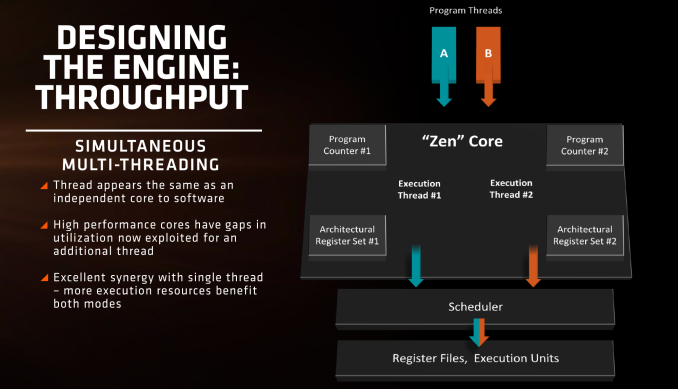AMD Zen Microarchitecture: Dual Schedulers, Micro-Op Cache and Memory Hierarchy Revealed
by Ian Cutress on August 18, 2016 9:00 AM ESTSimultaneous Multi-Threading
On Zen, each core will be able to support two threads in what is called ‘simulatenous multi-threading’. Intel has supported their version of SMT for a number of years, and other CPU manufacturers like IBM support up to 8 threads per core on their POWER8 platform designs. Building a core to be able to use multiple threads can be tough, as it requires a lot of resources to make sure that the threads do not block each other by consuming all the cache and buffers in play. But AMD will equip Zen with SMT which means we will see 8C/16T parts hitting the market.
Unlike Bulldozer, where having a shared FP unit between two threads was an issue for floating point performance, Zen’s design is more akin to Intel’s in that each thread will appear as an independent core and there is not that resource limitation that BD had. With sufficient resources, SMT will allow the core instructions per clock to improve, however it will be interesting to see what workloads will benefit and which ones will not.
Timeframe and Availability
At the presentation, it was given that Zen will be available in volume in 2017. As the AM4 platform will share a socket with Bristol Ridge, users are likely to see Bristol Ridge systems from AMD’s main OEM partners, like Dell and others, enter the market before separate Zen CPUs will hit the market for DIY builders. It’s a matter of principle that almost no consumer focused semiconductor company releases a product for the sale season, and Q1 features such events as CES, which gives a pretty clear indication of when we can expect to get our hands on one.
It’s worth noting that AMD said that as we get closer to launch, further details will come as well as deeper information about the design. It was also mentioned that the marketing strategy is also currently being determined, such that Zen may not actually be the retail product name for the line of processors (we already have Summit Ridge as the platform codename, but that could change for retail as well).
Wrap Up
AMD has gone much further into their core design than I expected this week. When we were told we had a briefing, and there were 200-odd press and analysts in the room, I was expecting to hear some high level puff about the brand and a reiteration of their commitment to the high end. To actually get some slides detailing parts of the microarchitecture, even at a basic cache level, was quite surprising and it somewhat means that AMD might have stolen the show with the news this week.
We’ve got another couple of pieces detailing some of the AMD internal/live benchmark numbers during the presentation, as well as the dual socket server platform, the 32-core Naples server CPU, and what we saw at the event in terms of motherboard design.











216 Comments
View All Comments
pogostick - Friday, August 19, 2016 - link
What's all this bickering about AMD and Intel. Open your eyes people. There is only one master x86 cpu company and it is VIA. Soaring on their successful acquisition of the Cyrix remains, they've forged ahead to make blisteringly fast products like their 64 bit QuadCore E-Series. It beats everything but my wife. Geez. You guys are CLUELESS.AndrewJacksonZA - Friday, August 19, 2016 - link
Hahahahaha!belph - Friday, August 19, 2016 - link
Competition is back (?)patel21 - Friday, August 19, 2016 - link
Yes sir, it sure is.Rickkins1 - Friday, August 19, 2016 - link
Without the competition that AMD provides, Intel cpu's would be priced out of range for most people.Michael Bay - Friday, August 19, 2016 - link
And then you remember that AMD didn`t provide any competition worth of note for the past eight years.just4U - Friday, August 19, 2016 - link
Ofcourse they did.. just not on the highest end of the scale. The PII was a great chip. The FX line is decent but hasn't really seen much love.. and their APU is an excellent product.Meteor2 - Friday, August 19, 2016 - link
Quite. Intel have only been competing against themselves these last years.Makaveli - Friday, August 19, 2016 - link
If that is true then why haven't Intel prices increase substantially in the last 10 year where AMD has not been competitive?Maybe because Intel competes with their own previous gen chips. AMD being the reason for Intel's keeping prices in check only works when they have a product that competes and forces them to.
BMNify - Friday, August 19, 2016 - link
so, what did AMD do to improve generic x264/x265 data throughput on 10bit 1080P and especially UHD1 rec.2020 software encoding throughput ?what did AMD do to improve ffmpeg and related downstream hardware UHD1 encoding/streaming etc.